2011 HYUNDAI TUCSON Windshield
[x] Cancel search: WindshieldPage 291 of 382
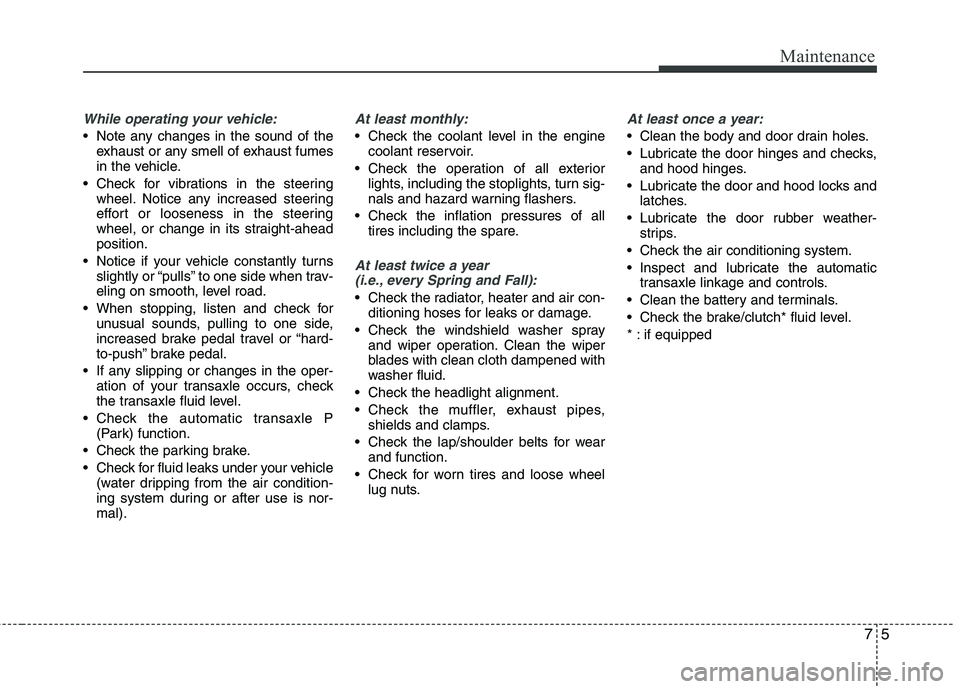
75
Maintenance
While operating your vehicle:
Note any changes in the sound of theexhaust or any smell of exhaust fumes
in the vehicle.
Check for vibrations in the steering wheel. Notice any increased steering
effort or looseness in the steering
wheel, or change in its straight-ahead position.
Notice if your vehicle constantly turns slightly or “pulls” to one side when trav-
eling on smooth, level road.
When stopping, listen and check for unusual sounds, pulling to one side,
increased brake pedal travel or “hard-
to-push” brake pedal.
If any slipping or changes in the oper- ation of your transaxle occurs, check
the transaxle fluid level.
Check the automatic transaxle P (Park) function.
Check the parking brake.
Check for fluid leaks under your vehicle (water dripping from the air condition-
ing system during or after use is nor-mal).
At least monthly:
Check the coolant level in the enginecoolant reservoir.
Check the operation of all exterior lights, including the stoplights, turn sig-
nals and hazard warning flashers.
Check the inflation pressures of all tires including the spare.
At least twice a year
(i.e., every Spring and Fall):
Check the radiator, heater and air con- ditioning hoses for leaks or damage.
Check the windshield washer spray and wiper operation. Clean the wiper
blades with clean cloth dampened with
washer fluid.
Check the headlight alignment.
Check the muffler, exhaust pipes, shields and clamps.
Check the lap/shoulder belts for wear and function.
Check for worn tires and loose wheel lug nuts.
At least once a year:
Clean the body and door drain holes.
Lubricate the door hinges and checks,and hood hinges.
Lubricate the door and hood locks and latches.
Lubricate the door rubber weather- strips.
Check the air conditioning system.
Inspect and lubricate the automatic transaxle linkage and controls.
Clean the battery and terminals.
Check the brake/clutch* fluid level.
* : if equipped
Page 310 of 382
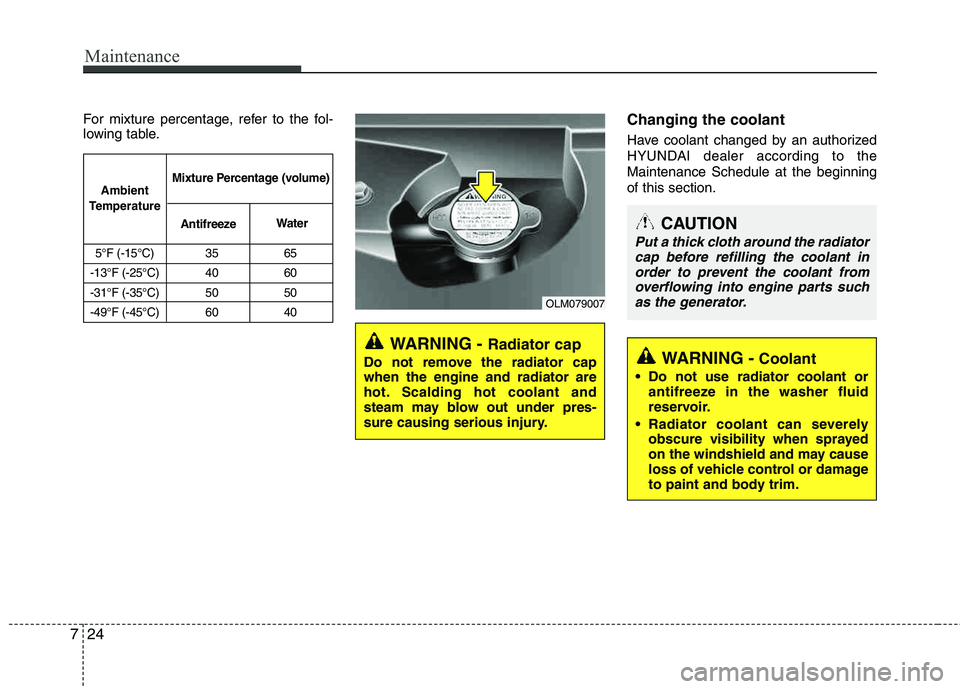
Maintenance
24
7
For mixture percentage, refer to the fol-
lowing table.Changing the coolant
Have coolant changed by an authorized
HYUNDAI dealer according to theMaintenance Schedule at the beginningof this section.
WARNING - Radiator cap
Do not remove the radiator cap when the engine and radiator are
hot. Scalding hot coolant and
steam may blow out under pres-
sure causing serious injury.
OLM079007
CAUTION
Put a thick cloth around the radiator
cap before refilling the coolant inorder to prevent the coolant from
overflowing into engine parts suchas the generator.
WARNING -Coolant
Do not use radiator coolant or antifreeze in the washer fluid
reservoir.
Radiator coolant can severely obscure visibility when sprayed
on the windshield and may cause
loss of vehicle control or damage
to paint and body trim.
5°F (-15°C) 35 65
-13°F (-25°C) 40 60
-31°F (-35°C) 50 50
-49°F (-45°C) 60 40
Ambient
Temperature Mixture Percentage (volume)
Antifreeze Water
Page 312 of 382
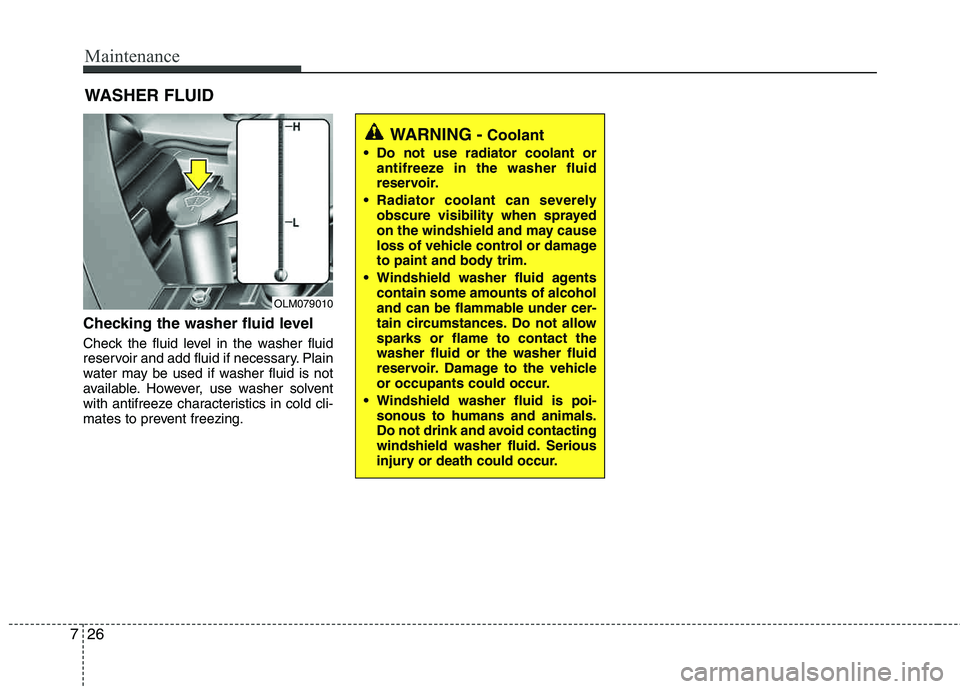
Maintenance
26
7
WASHER FLUID
Checking the washer fluid level
Check the fluid level in the washer fluid
reservoir and add fluid if necessary. Plain
water may be used if washer fluid is not
available. However, use washer solvent
with antifreeze characteristics in cold cli-
mates to prevent freezing.
WARNING -Coolant
Do not use radiator coolant or
antifreeze in the washer fluid
reservoir.
Radiator coolant can severely obscure visibility when sprayed
on the windshield and may cause
loss of vehicle control or damage
to paint and body trim.
Windshield washer fluid agents contain some amounts of alcohol
and can be flammable under cer-
tain circumstances. Do not allow sparks or flame to contact thewasher fluid or the washer fluid
reservoir. Damage to the vehicle
or occupants could occur.
Windshield washer fluid is poi- sonous to humans and animals.
Do not drink and avoid contacting
windshield washer fluid. Serious
injury or death could occur.
OLM079010
Page 317 of 382
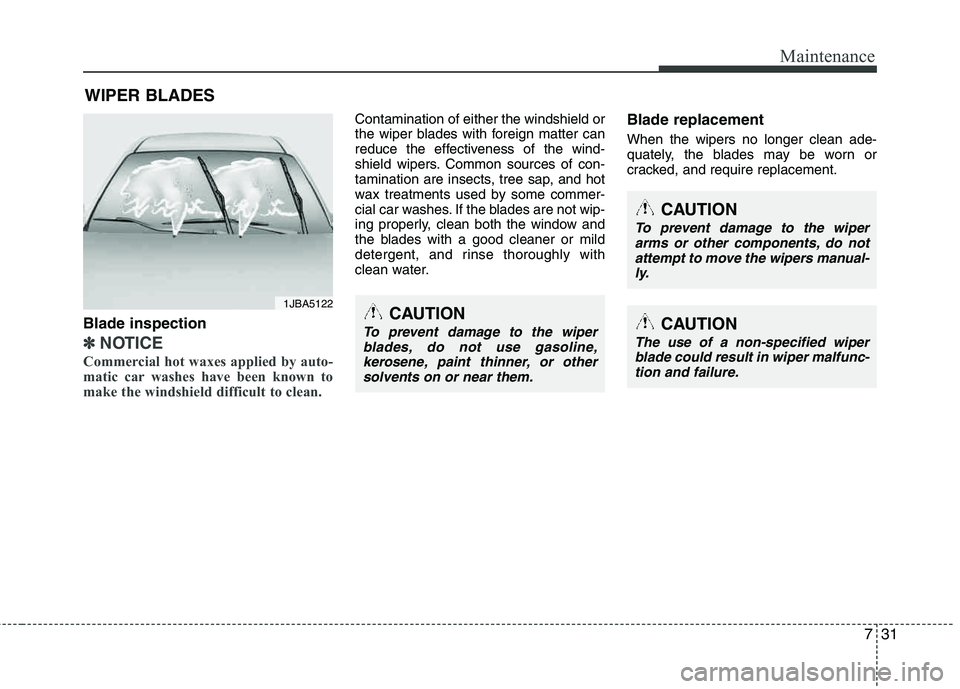
731
Maintenance
WIPER BLADES
Blade inspection
✽✽NOTICE
Commercial hot waxes applied by auto-
matic car washes have been known to
make the windshield difficult to clean.
Contamination of either the windshield or
the wiper blades with foreign matter can
reduce the effectiveness of the wind-
shield wipers. Common sources of con-
tamination are insects, tree sap, and hot
wax treatments used by some commer-
cial car washes. If the blades are not wip-
ing properly, clean both the window and
the blades with a good cleaner or mild
detergent, and rinse thoroughly with
clean water.Blade replacement
When the wipers no longer clean ade-
quately, the blades may be worn or
cracked, and require replacement.
1JBA5122CAUTION
To prevent damage to the wiper blades, do not use gasoline,
kerosene, paint thinner, or othersolvents on or near them.
CAUTION
To prevent damage to the wiperarms or other components, do notattempt to move the wipers manual-
ly.
CAUTION
The use of a non-specified wiperblade could result in wiper malfunc-
tion and failure.
Page 318 of 382
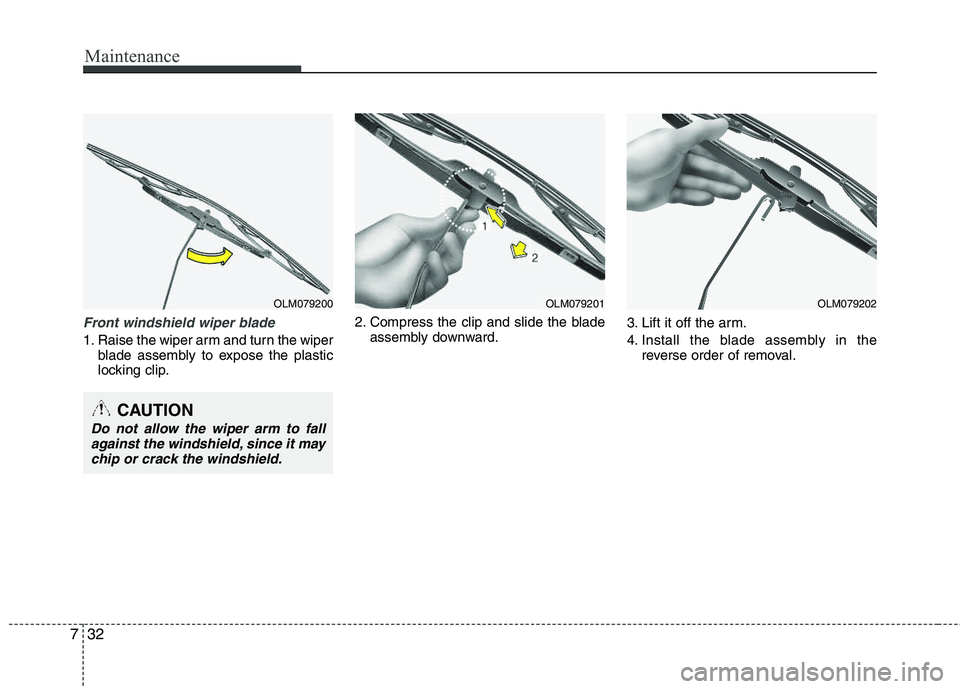
Maintenance
32
7
Front windshield wiper blade
1. Raise the wiper arm and turn the wiper
blade assembly to expose the plastic
locking clip. 2. Compress the clip and slide the blade
assembly downward. 3. Lift it off the arm.
4. Install the blade assembly in the
reverse order of removal.
CAUTION
Do not allow the wiper arm to fall
against the windshield, since it may
chip or crack the windshield.
OLM079200OLM079201OLM079202
Page 367 of 382
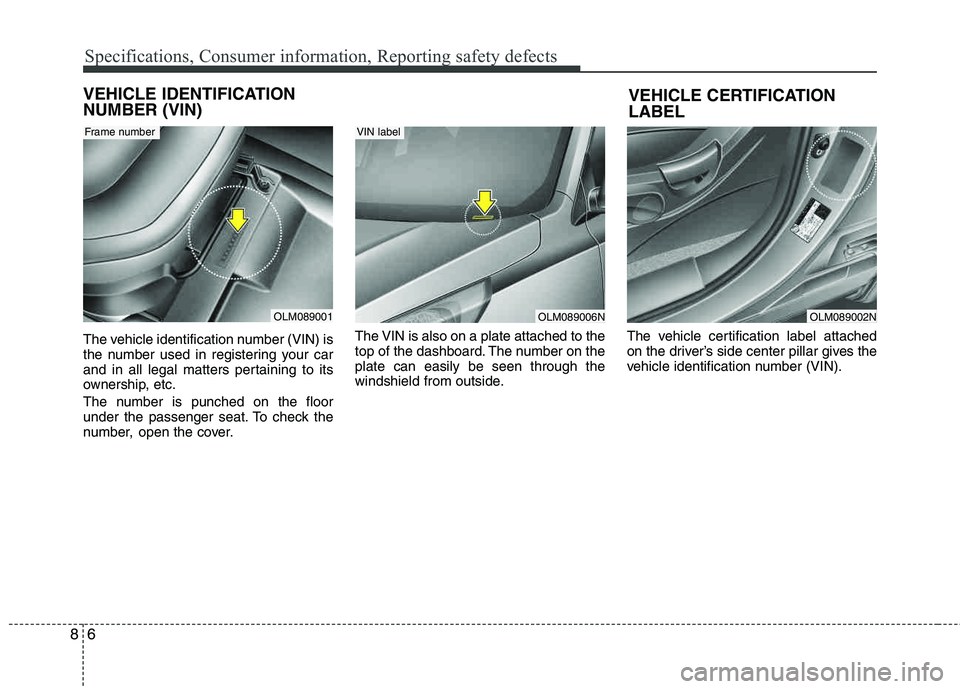
Specifications, Consumer information, Reporting safety defects
6
8
VEHICLE IDENTIFICATION NUMBER (VIN)
The vehicle identification number (VIN) is
the number used in registering your car
and in all legal matters pertaining to its
ownership, etc.
The number is punched on the floor
under the passenger seat. To check the
number, open the cover. The VIN is also on a plate attached to the
top of the dashboard. The number on the plate can easily be seen through the
windshield from outside.
The vehicle certification label attached
on the driver’s side center pillar gives the
vehicle identification number (VIN).
OLM089002N
VEHICLE CERTIFICATION LABELOLM089006NOLM089001
Frame numberVIN label
Page 375 of 382
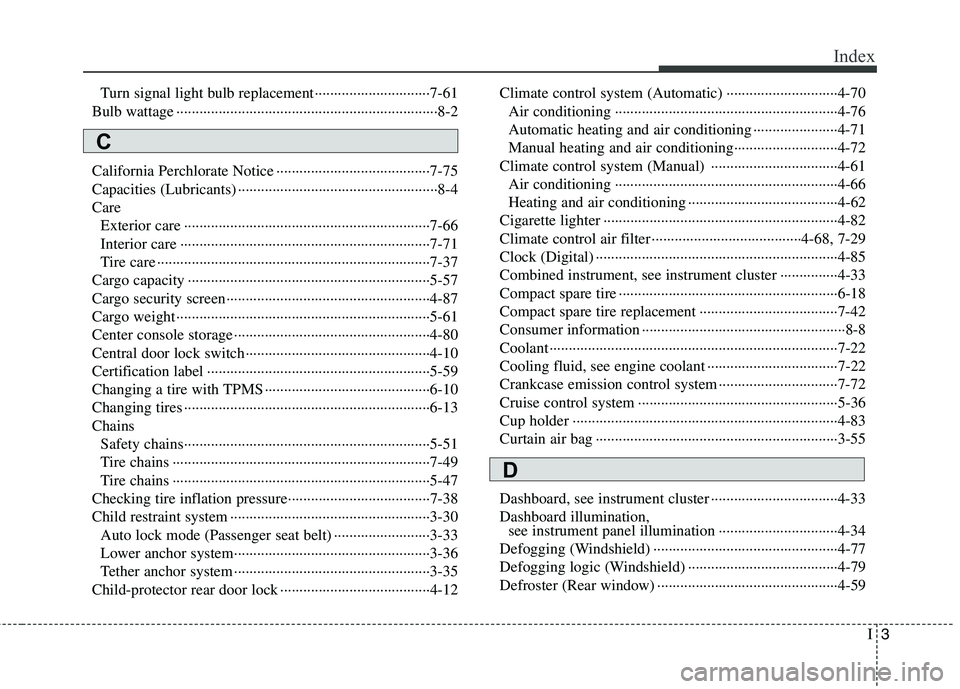
I3
Index
Turn signal light bulb replacement······························7-61
Bulb wattage ····································································8-2
California Perchlorate Notice ········································7-75
Capacities (Lubricants) ····················································8-4Care Exterior care ································································7-66
Interior care ·································································7-71
Tire care ·······································································7-37
Cargo capacity ·······························································5-57
Cargo security screen·····················································4-87
Cargo weight ··································································5-61
Center console storage ···················································4-80
Central door lock switch················································4-10
Certification label ··························································5-59
Changing a tire with TPMS ···········································6-10
Changing tires ································································6-13Chains Safety chains································································5-51
Tire chains ···································································7-49
Tire chains ···································································5-47
Checking tire inflation pressure·····································7-38
Child restraint system ····················································3-30 Auto lock mode (Passenger seat belt) ·························3-33
Lower anchor system···················································3-36
Tether anchor system ···················································3-35
Child-protector rear door lock ·······································4-12 Climate control system (Automatic) ·····························4-70
Air conditioning ··························································4-76
Automatic heating and air conditioning ······················4-71
Manual heating and air conditioning···························4-72
Climate control system (Manual) ·································4-61 Air conditioning ··························································4-66
Heating and air conditioning ·······································4-62
Cigarette lighter ·····························································4-82
Climate control air filter ·······································4-68, 7-29
Clock (Digital) ·······························································4-85
Combined instrument, see instrument cluster ···············4-33
Compact spare tire ·························································6-18
Compact spare tire replacement ····································7-42
Consumer information ·····················································8-8
Coolant ···········································································7-22
Cooling fluid, see engine coolant ··································7-22
Crankcase emission control system ·······························7-72
Cruise control system ····················································5-36
Cup holder ·····································································4-83
Curtain air bag ·······························································3-55
Dashboard, see instrument cluster ·································4-33 Dashboard illumination, see instrument panel illumination ·······························4-34
Defogging (Windshield) ················································4-77
Defogging logic (Windshield) ·······································4-79
Defroster (Rear window) ···············································4-59
C
D
Page 376 of 382

Index
4I
Defrosting (Windshield) ················································4-77
Digital clock···································································4-85
Dimensions ······································································8-2
Displays, see instrument cluster ····································4-33
Display illumination, see instrument panel illumination···4-34
Door locks········································································4-9 Central door lock switch ·············································4-10
Child-protector rear door lock ·····································4-12
Drinks holders, see cup holders·····································4-83
Driver's air bag·······························································3-49
Driving at night ······························································5-43
Driving in flooded areas ················································5-44
Driving in the rain··························································5-44
Economical operation ····················································5-40
Electronic power steering ·············································4-28
Electronic stability control (ESC) ·································5-29
Emergency starting ··························································6-4 Jump starting ·································································6-4
Push starting ··································································6-5
Emergency tailgate safety release··································4-14
Emergency towing ·························································6-21
Emergency while driving ·················································6-2
Emission control system ················································7-72 Crankcase emission control system·····························7-72
Evaporative emission control (including ORVR) System ·······································································7-72
Exhaust emission control system ································7-73 Engine compartment ················································2-4, 7-2
Engine coolant ·······························································7-22
Engine number ·································································8-7
Engine oil ·······································································7-21
Engine overheats ······························································6-6
Engine temperature gauge ·············································4-35
Engine will not start·························································6-3
Evaporative emission control (including ORVR) System ··
7-72
Exhaust emission control system···································7-73
Explanation of scheduled maintenance items ···············7-18
Exterior care···································································7-66
Exterior features·····························································4-88 Roof rack ·····································································4-88
Flat tire ···········································································6-12 Changing tires······························································6-13
Compact spare tire ·······················································6-18
Jack and tools ······························································6-12
Removing and storing the spare tire····························6-13
Floor mat anchor(s) ·······················································4-85Fluid Brakes/clutch fluid·······················································7-25
Washer fluid·································································7-26
Folding the rear seat ······················································3-13
Four wheel drive (4WD), See all wheel drive (AWD) ··5-17
Front fog light bulb replacement ···································7-61
Front seat adjustment - manual ·······································3-5
Front seat adjustment - power ·········································3-6
EF